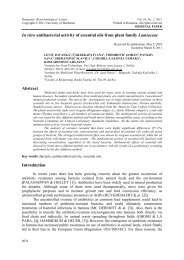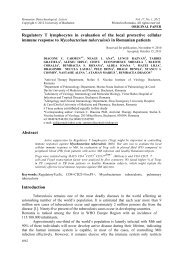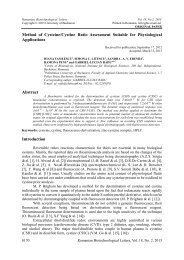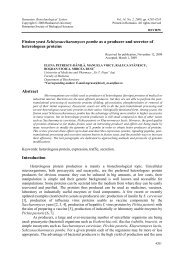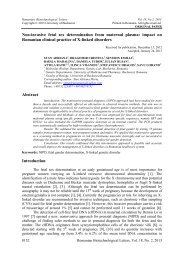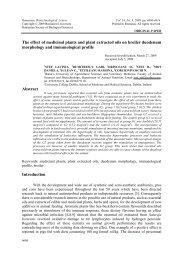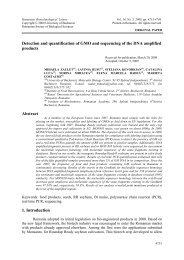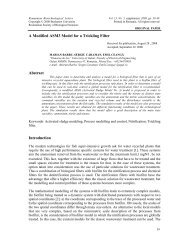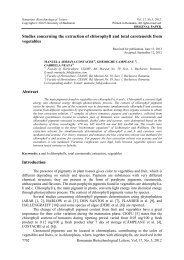Isolation and characterization of lactic acid bacteria ... - Rombio.eu
Isolation and characterization of lactic acid bacteria ... - Rombio.eu
Isolation and characterization of lactic acid bacteria ... - Rombio.eu
You also want an ePaper? Increase the reach of your titles
YUMPU automatically turns print PDFs into web optimized ePapers that Google loves.
Romanian Biotechnological Letters<br />
Copyright © 2011 University <strong>of</strong> Bucharest<br />
Vol. 16, No.6, 2011, Supplement<br />
Printed in Romania. All rights reserved<br />
SHORT COMMUNICATION<br />
<strong>Isolation</strong> <strong>and</strong> <strong>characterization</strong> <strong>of</strong> <strong>lactic</strong> <strong>acid</strong> <strong>bacteria</strong> from romanian<br />
fermented vegetables<br />
Abstract<br />
Received for publication, October 7, 2011<br />
Accepted, November 21, 2011<br />
1 SILVIA SIMONA GROSU-TUDOR, 1* MEDANA ZAMFIR<br />
1 Institute <strong>of</strong> Biology Bucharest <strong>of</strong> Romanian Academy,<br />
296 Splaiul Independentei, 060031 Bucharest, P.O. Box 56-53, ROMANIA<br />
* Corresponding author, phone: (021)2239072; fax: (021)2239071;<br />
e-mail: medana.zamfir@ibiol.ro<br />
Fermentation was used since ancient times as an easy method <strong>of</strong> vegetables’ preservation,<br />
which also maintains <strong>and</strong>/or improves the nutritional <strong>and</strong> sensory properties <strong>of</strong> vegetables. The<br />
spontaneous fermentation process is mainly carried out by <strong>lactic</strong> <strong>acid</strong> <strong>bacteria</strong> (LAB). The aim <strong>of</strong> our<br />
study was to isolate <strong>and</strong> characterize the LAB involved in such spontaneous fermentations. Brine <strong>and</strong><br />
vegetable samples were collected from 20 fermentations carried out at household level. They were<br />
analysed for <strong>acid</strong>ification <strong>and</strong> plated on VRBG agar medium (for enumeration <strong>of</strong> entero<strong>bacteria</strong>ceae)<br />
<strong>and</strong> MRS agar medium (for enumeration <strong>and</strong> isolation <strong>of</strong> LAB). The cell morphology, growth at<br />
different temperatures, capsular polysaccharide production, mucoidness <strong>and</strong> ropyness <strong>of</strong> the colonies<br />
for the Gram-positive, catalase-negative isolates (139) were investigated. LAB were prevalent in all<br />
end-samples, as represented by their MRS counts, whereas entero<strong>bacteria</strong>l counts were low in most<br />
cases, indicating good fermentation quality. All isolates grew well at 37ºC <strong>and</strong> 45ºC, in only 24h, while<br />
the growth at 10ºC was slower for some <strong>of</strong> them (72h). The cells are rod-shaped for most <strong>of</strong> the isolates,<br />
while the others are cocci <strong>and</strong> coccobacilli. All except five isolates were shown to produce capsular<br />
polysaccharide <strong>and</strong> 31 developed mucoid colonies on sucrose-based media.<br />
Key words: <strong>lactic</strong> <strong>acid</strong> <strong>bacteria</strong>, fermented vegetables<br />
Introduction<br />
Fermented vegetables represent a frequently used food in Romania, especially during<br />
the winter. The preservation is based on the property <strong>of</strong> <strong>lactic</strong> <strong>acid</strong> <strong>bacteria</strong> (LAB) to ferment<br />
sugars to <strong>lactic</strong> <strong>acid</strong>, causing an <strong>acid</strong>ification <strong>and</strong> hence, a stabilization <strong>of</strong> the end product.<br />
The most common vegetables used are cucumbers, cabbage, <strong>and</strong> bell peppers (paprika). Green<br />
tomatoes, carrots, <strong>and</strong> cauliflower are used too, sometimes mixed with fruits (water melon,<br />
apples, or pears). During the spontaneous fermentation, LAB mostly found belong to<br />
Lactobacillus sp. (L. plantarum, L. brevis), L<strong>eu</strong>conostoc sp. (L. mesenteroides) <strong>and</strong><br />
Pediococcus sp. (P. pentosac<strong>eu</strong>s, P. cerevisiae) (Miambi & al. [1], Chao & al. [2], Nakayama<br />
& al. [3], Kim & al. [4]).<br />
Traditional preservation <strong>of</strong> vegetables <strong>and</strong> fruits by the process <strong>of</strong> <strong>lactic</strong> <strong>acid</strong><br />
fermentation has numerous advantages beyond those <strong>of</strong> preservation. The proliferation <strong>of</strong><br />
LAB in fermented vegetables enhances their digestibility <strong>and</strong> increases the vitamin levels <strong>and</strong><br />
vitamin bioavailability. These beneficial organisms contribute to the organoleptic properties<br />
<strong>of</strong> the fermented product <strong>and</strong> to its preservation by in situ production <strong>of</strong> antimicrobial<br />
substances such as <strong>lactic</strong> <strong>and</strong> acetic <strong>acid</strong>, hydrogen peroxide, bacteriocins etc. (De Vuyst &<br />
V<strong>and</strong>amme [5]). Their main end product, <strong>lactic</strong> <strong>acid</strong>, not only keeps vegetables <strong>and</strong> fruits in a<br />
state <strong>of</strong> perfect preservation but can also promote the growth <strong>of</strong> healthy microbiota<br />
throughout the intestine. Public awareness <strong>of</strong> effects <strong>of</strong> diet on gut health <strong>and</strong> a healthy gut<br />
microbiota is resulting in the consumption <strong>of</strong> products that mantain health in addition to<br />
148
SILVIA SIMONA GROSU-TUDOR, MEDANA ZAMFIR<br />
preventing disease. In Romania some fermented vegetables (especially sauerkraut) are<br />
sometimes used as “therap<strong>eu</strong>tic agents”, especially for stomach disorders.<br />
Many LAB strains have the ability to produce exopolysaccharides (EPS), with an<br />
important role in the rheology <strong>and</strong> texture properties <strong>of</strong> fermented food products, <strong>and</strong> thus <strong>of</strong><br />
interest for food applications as in situ produced, natural bio-thickeners (De Vuyst &<br />
Vaningelgem [6]). It has been suggested that some EPS produced by LAB have prebiotic<br />
activity (Ruijssenaars [7], Salazar [8]), contributing to the promotion <strong>of</strong> human<br />
gastrointestinal health.<br />
Traditionally fermented foods, including fermented vegetables, can be a rich source <strong>of</strong><br />
new LAB strains, with interesting functional properties <strong>and</strong> with potential applications in food<br />
industry <strong>and</strong> health. In this context, the aim <strong>of</strong> our study was to isolate <strong>and</strong> characterize new<br />
LAB strains from various fermented vegetables, in a search for new EPS-producing strains.<br />
Materials <strong>and</strong> methods<br />
Bacterial strains <strong>and</strong> media. Brine <strong>and</strong> vegetable samples were collected from 20<br />
spontaneous vegetable fermentations (Table 1) carried out at a household level in the region<br />
<strong>of</strong> Valenii de Munte (Chiojdu) <strong>and</strong> Bucharest. For fermentations 19 <strong>and</strong> 20, nine additional<br />
samples were also collected during the 5 weeks <strong>of</strong> fermentation, at diferent time intervals.<br />
Samples were analysed for <strong>acid</strong>ification (pH measurements) <strong>and</strong> plated on VRBG agar<br />
medium (for enumeration <strong>of</strong> entero<strong>bacteria</strong>ceae, Mossel & al. [9]) <strong>and</strong> MRS agar medium (for<br />
enumeration <strong>and</strong> isolation <strong>of</strong> LAB, de Man & al. [10]). Colonies were r<strong>and</strong>omly picked up,<br />
purified <strong>and</strong> tested for catalase production <strong>and</strong> Gram-staining. Gram-positive, catalasenegative<br />
isolates were stored at -75°C in liquid MRS medium supplemented with 25%<br />
(vol/vol) <strong>of</strong> glycerol as cryoprotectant <strong>and</strong> used in our further experiments.<br />
Characterization <strong>of</strong> LAB isolated from Romanian fermented vegetables. To determine<br />
the mesophilic/thermophilic character, the strains isolated from Romanian fermented<br />
vegetables were incubated in MRS at different temperatures: 10°C, 37°C <strong>and</strong> 45°C. After 24–<br />
72 h <strong>of</strong> incubation at these temperatures, the pH <strong>and</strong> the optical density at 600 nm was<br />
measured. If the growth <strong>of</strong> the strains occurs between 10°C <strong>and</strong> 37°C <strong>and</strong> there is no growth<br />
observed at temperatures higher than 45°C, they are mesophilic, while the strains showing a<br />
good growth at 45°C, but not able to grow at 10°C are thermophilic (G. Zarnea [11]).<br />
The cell morphology <strong>of</strong> the isolates was observed by microscopical examination <strong>of</strong> the Gramstained<br />
slides.<br />
In order to evaluate the capacity to produce exopolysaccharides, the isolates were cultivated<br />
on four different media: MRS with 20 g liter -1 <strong>of</strong> glucose, modified MRS (mMRS) with 50g<br />
liter -1 <strong>of</strong> sucrose instead <strong>of</strong> glucose, ST (Dave & Shah [12]) with 10 g liter -1 <strong>of</strong> lactose <strong>and</strong><br />
modified ST (mST) with 50 g liter -1 <strong>of</strong> sucrose instead <strong>of</strong> lactose. After 24 h <strong>of</strong> incubation at<br />
37°C, the mucoidness <strong>and</strong> ropyness <strong>of</strong> the colonies was observed. The mucoid colonies have a<br />
glistening <strong>and</strong> slimy appearance on agar plates, but are not able to produce str<strong>and</strong>s when<br />
extended with a stik, whereas the ropy colonies form a long filament by this method<br />
(Dierksen & al. [13]).<br />
Capsular polysaccharide (CPS) formation was evaluated by the Chinese ink negative staining<br />
technique (Mozzi & al. [14]) after growing the strains on MRS with different carbon sources<br />
<strong>and</strong> at different temperatures (10°C, 37°C <strong>and</strong> 45°C). Ten microliters <strong>of</strong> a fresh culture was<br />
mixed with a drop <strong>of</strong> Chinese ink <strong>and</strong> spread on a slide in a thin film, coverred with a cover<br />
glass <strong>and</strong> examined.<br />
Romanian Biotechnological Letters, Vol. 16, No. 6, Supplement (2011) 149
<strong>Isolation</strong> <strong>and</strong> <strong>characterization</strong> <strong>of</strong> <strong>lactic</strong> <strong>acid</strong> <strong>bacteria</strong> from romanian fermented vegetables<br />
Results <strong>and</strong> discussions<br />
The final pH <strong>of</strong> the brines <strong>of</strong> all end-samples <strong>of</strong> the different spontaneous vegetable<br />
fermentations carried out was on average pH 3.6. LAB were prevalent in all end-samples, as<br />
represented by their MRS counts [ca. 10 9 (cfu/ml)], whereas entero<strong>bacteria</strong>l counts were low<br />
in most cases, indicating good fermentation quality (data not shown).<br />
A total <strong>of</strong> 150 colonies were picked up from the MRS plates, purified <strong>and</strong> checked for<br />
catalase production <strong>and</strong> Gram staining. A number <strong>of</strong> 139 isolates were shown to be Grampositive<br />
<strong>and</strong> catalase-negative. The latter isolates were used for further <strong>characterization</strong>.<br />
All the isolates grew very well at 37°C, reaching an OD 600nm <strong>of</strong> over 1.2 after 24 h <strong>of</strong><br />
incubation. Generally, 37°C is considered the optimal temperature for most species <strong>of</strong> <strong>lactic</strong><br />
<strong>acid</strong> <strong>bacteria</strong> (Zarnea, [11]). The isolates were able to grow well also at 10°C, 35 isolates<br />
reaching an OD 600nm <strong>of</strong> over 0.5 after only 24 h <strong>of</strong> incubation. The other isolates needed 48 h<br />
(95 isolates) or even 72 h (9 isolates) <strong>of</strong> incubation to reach the same OD value. At 45°C, all<br />
isolates showed a good growth after 24 hours <strong>of</strong> incubation (OD 600nm over 0.5) . The pH<br />
values <strong>of</strong> the <strong>bacteria</strong>l cultures ranged between 3.0 <strong>and</strong> 5.0 for the isolates incubated at 37°C<br />
<strong>and</strong> 45°C, <strong>and</strong> around 5.0 for the isolates incubated at 10°C. Since all isolates could grow at<br />
all tested temperatures, we could not make, at this point, a distinction between their<br />
thermophilic/mesophilic character.<br />
The cell morphology <strong>of</strong> all 139 isolates was evaluated by microscopical observations<br />
using the immersion objective. The cells from most <strong>of</strong> the isolates (95) were rod-shaped,<br />
from other 32 were coccoid, from eleven were cocobacillar <strong>and</strong> from one isolate had a<br />
diplococcal shape (Table 1).<br />
Table 1. Overview <strong>of</strong> the spontaneous vegetables fermentations <strong>and</strong> <strong>characterization</strong> <strong>of</strong> the isolates<br />
Fermented product<br />
Time <strong>of</strong><br />
sampling<br />
No. <strong>of</strong><br />
isolates<br />
Mucoid<br />
isolates<br />
(MRS<br />
suc)<br />
CPS<br />
positive<br />
(MRS<br />
gluc)<br />
Cell morphology<br />
1. Cucumber <strong>and</strong> plums 8 weeks 4 0 4 rods (2)<br />
cocobacilli (2)<br />
2.Green tomato 4 weeks 4 0 4 rods (3)<br />
cocci (1)<br />
3.Cucumber <strong>and</strong> beans 8 weeks 1 1 0 rods (1)<br />
4.Cucumber <strong>and</strong> carrots 6 weeks 0 0 0 -<br />
5.Green tomato 8 weeks 6 0 4 rods (6)<br />
6.Cucumber 12 weeks 0 0 0 -<br />
7.Green tomato, beets <strong>and</strong> 8 weeks 1 0 0 cocobacilli (1)<br />
cabbage<br />
8.Cucumber <strong>and</strong><br />
cauliflower<br />
6 weeks 6 1 2 rods (4)<br />
cocobacilli (2)<br />
9.Green tomato 4 weeks 4 2 3 rods (3)<br />
cocobacilli (1)<br />
10.Green tomato, apple,<br />
pear, <strong>and</strong> cucumber 2 weeks 9 2 9<br />
rods (2)<br />
cocci (4)<br />
cocobacilli (3)<br />
11.Green tomato, apple,<br />
pear <strong>and</strong> cucumber 2 weeks 12 3 5<br />
rods (7)<br />
cocobacilli (2)<br />
cocci (3)<br />
12.Green tomato, carrots 8 weeks 5 1 4 rods (5)<br />
<strong>and</strong> celery<br />
13.Cabbage <strong>and</strong> beet 4 weeks 5 2 3 rods (5)<br />
14.Cabbage 8 weeks 3 0 3 rods (3)<br />
15.Green tomato, carrots<br />
<strong>and</strong> cauliflower 8 weeks 8 3 7 rods (8)<br />
150 Romanian Biotechnological Letters, Vol. 16, No. 6, Supplement (2011)
SILVIA SIMONA GROSU-TUDOR, MEDANA ZAMFIR<br />
16.Cabbage 4 weeks 5 0 5 rods (5)<br />
17.Pepper filled with 8 weeks 9 0 6 rods (9)<br />
cabbage<br />
18.Cucumber 4 weeks 6 2 6 rods (6)<br />
19.Green tomato,<br />
cauliflower, carrots,<br />
pepper <strong>and</strong> celery<br />
5 weeks 32 11 23<br />
rods (16)<br />
cocci (15)<br />
diplococci (1)<br />
20.Cauliflower 5 weeks 19 3 10 rods (10)<br />
cocci (9)<br />
Most <strong>of</strong> the isolates (87) grew well in all four media used (MRS, mMRS, ST, <strong>and</strong><br />
mST), but it was observed a preference for sucrose as a carbon source. Thirty-one strains<br />
developed mucoid colonies on MRS with sucrose (Table 1, Fig 1a) <strong>and</strong> less or no mucoid on<br />
media with glucose or lactose as a carbon source (data not shown). In some cases, due to the<br />
small size <strong>of</strong> the colonies, the mucoidness <strong>and</strong> ropyness phenotype could not be detected.<br />
a. b.<br />
Fig 1. Mucoidness (a) <strong>and</strong> ropynes (b) <strong>of</strong> the colonies developed on agar plates by the isolate 52 <strong>and</strong> isolate 371,<br />
respectively.<br />
Results are in accordance with those obtained by Van Geel-Schutten & al. [15] who<br />
screened several Lactobacillus strains <strong>of</strong> different origins (fermented food, human dental<br />
plaque etc.) for mucoid phenotype in MRS medium supplemented with high concentrations<br />
(100 g liter -1 ) <strong>of</strong> different sugars: glucose, fructose, maltose, raffinose, sucrose, galactose or<br />
lactose. The MRS supplemeted with sucrose was the best medium for detecting the mucoide<br />
phenotype. The autors attributed the high percentage <strong>of</strong> positive isolates to the high content <strong>of</strong><br />
sugar used in the medium. Also, Smitinont & al. [16] observed slimy colonies on agar media<br />
containing sucrose as a sole carbon source.<br />
None <strong>of</strong> the mucoid colonies showed a ropy phenotype. There were, however, two<br />
isolates (338 <strong>and</strong> 371) that developed ropy colonies on sucrose containing media (Fig 1b).<br />
Some LAB (e.g. Lactococcus lactis spp. cremoris Ropy352, Lactobacillus casei CG11) were<br />
described in the literature to express both ropy <strong>and</strong> mucoid phenotypes, depeding on the<br />
growth conditions (Dierksen & al. [13], Cerning & al. [17]). In Lactococcus lactis spp.<br />
cremoris Ropy352, it has been shown that this ability is due to the production <strong>of</strong> two<br />
exopolysaccharides with different chemical composition (Knoshaug & al. [18]).<br />
It was shown that ropy strains <strong>of</strong> LAB yield fermented milk products having smoother body,<br />
higher viscosity, <strong>and</strong> less syneresis than products made with nonropy strains (Bouzar & al.<br />
Romanian Biotechnological Letters, Vol. 16, No. 6, Supplement (2011) 151
<strong>Isolation</strong> <strong>and</strong> <strong>characterization</strong> <strong>of</strong> <strong>lactic</strong> <strong>acid</strong> <strong>bacteria</strong> from romanian fermented vegetables<br />
[19]) <strong>and</strong> are <strong>of</strong> particular interest in Sc<strong>and</strong>inavian milk products such as viili <strong>and</strong> langmjolk.<br />
Ropy starter cultures also provide benefits for yogurt production (Broadbent & al. [20]). In<br />
Mexico, where the milk supply routinely faces shortages, yogurt can be made with less total<br />
milk solids if a ropy starter culture is used (Wacher-Rodante & al. [21]).<br />
In fermented vegetables, however, ropiness might be a disadvantage for the<br />
appearance <strong>of</strong> the final product. It was previously shown that depending on the culture<br />
medium <strong>and</strong> conditions, some strains can produce excessive ropiness <strong>and</strong> undesirable<br />
characteristics (Toba & al. [22]).<br />
The polysaccharide caspule formation was investigated for the 139 isolates, by<br />
microscopical observation after staining with Chinese ink. Ten out <strong>of</strong> the 139 isolates,<br />
r<strong>and</strong>omly selected, were tested for capsule production on different media (MRS, mMRS, ST,<br />
<strong>and</strong> mST) <strong>and</strong> at different incubation temperatures (10°C, 37°C, <strong>and</strong> 45°C). Because no<br />
signifiant differences were observed in the presence/absence <strong>of</strong> the polysaccharide capsule in<br />
these different conditions, MRS medium was further used for the growth <strong>of</strong> tested isolates <strong>and</strong><br />
incubation was performed at 37°C.<br />
Twenty six isolates showed a clear, large capsule (Fig 2), 72 showed a medium<br />
capsule, 36 showed a small capsule <strong>and</strong> for 5 <strong>of</strong> them no capsule was observed. CPS <strong>of</strong><br />
different sizes was detected in all mucoid <strong>and</strong> ropy isolates. It is, however, difficult to make a<br />
precise correlation between the ropy/mucoid phenotype, CPS production <strong>and</strong> production <strong>of</strong><br />
exopolysaccharaides (Van der M<strong>eu</strong>len & al. [23]).<br />
Fig 2. Capsular polysaccharide sorrounding the cells <strong>of</strong> the isolate 326<br />
Capsule formation can be found among both nonropy <strong>and</strong> ropy strains. Streptococcus<br />
thermophilus OR901, a strain isolated from commercial yogurt <strong>and</strong> able to form ropy str<strong>and</strong>s<br />
from the cell mass, appeared encapsulated using light microscopy with Indian ink staining<br />
(Ariha & al. [24]). This was due to the production <strong>of</strong> two EPS with the same monosaccharide<br />
composition <strong>and</strong> branching linkage, but with different molecular mass. The EPS with the<br />
higher molar mass was assumed to affect physical (texture <strong>and</strong> viscosity) properties <strong>of</strong> yogurt<br />
<strong>and</strong> the EPS with lower molecular mass was thought to be located in the capsule, given that it<br />
was only released from the cell surface after sonication (Ariha & al. [24]). Thick-layered CPS<br />
have been shown to protect <strong>bacteria</strong> against phage infection (Kang & Cottrell, [25]).<br />
However, the involvement <strong>of</strong> CPS in the phage infection process <strong>of</strong> LAB is still unclear. The<br />
industrial interest in <strong>bacteria</strong>l strains producing CPS has increased in recent years because the<br />
use <strong>of</strong> these strains for milk fermentation improves cheese moisture retention <strong>and</strong> cheesemelting<br />
ability (Broadbent & al. [26]). Thus, substantial efforts have been devoted to<br />
developing methods to optimize CPS biosynthesis.<br />
152 Romanian Biotechnological Letters, Vol. 16, No. 6, Supplement (2011)
SILVIA SIMONA GROSU-TUDOR, MEDANA ZAMFIR<br />
Conclusions<br />
This study was undertaken to isolate <strong>and</strong> characterize new <strong>lactic</strong> <strong>acid</strong> <strong>bacteria</strong> involved in the<br />
spontaneous Romanian vegetables fermentations. It was proven that fermented vegetables are<br />
a rich source <strong>of</strong> LAB, 139 isolates being obtained from 20 different fermented products. All<br />
isolates except five were shown to produce capsular polysaccharide <strong>and</strong> 31 developed mucoid<br />
clonies on sucrose-based media <strong>and</strong> some <strong>of</strong> them might be further selected as EPS-producing<br />
strains <strong>and</strong> tested for their potential applications in food industry (for the production <strong>of</strong> food<br />
with improved rheological properties) or health (prebiotics).<br />
Acknowledgements<br />
The authors acknowledge their financial support <strong>of</strong> the Postdoctoral Research Project<br />
PD_33/2010 <strong>of</strong> the Romanian National Research Plan (PNII-RU). Part <strong>of</strong> this work was<br />
supported by the project no. RO1567-IBB05/2011 from the Institute <strong>of</strong> Biology Bucharest <strong>of</strong><br />
Romanian Academy.<br />
References<br />
1. E. MIAMBI, J.P. GUYOT, F. AMPE, Identification, isolation <strong>and</strong> quantification <strong>of</strong> representative<br />
<strong>bacteria</strong> from fermented cassava dough using an integrated approach <strong>of</strong> culture-dependent <strong>and</strong> cultureindependent<br />
methods. Int. J. Food Microbiol., 82, 111, 120 (2003).<br />
2. S.H. CHAO, Y TOMII, K. WANTANABE, Y.C. TSAI, Diversity <strong>of</strong> <strong>lactic</strong> <strong>acid</strong> <strong>bacteria</strong> in fermented<br />
brines used to make stinky t<strong>of</strong>u, Int. J. Food Microbiol. 123, 134, 141(2008).<br />
3. J. NAKAYAMA, H. HOSHIKO, M. FUKUDA, H. TANAKA, N. SAKAMOTO, S. TANAKA, K.<br />
OHUE, K. SAKAI, K. SONOMOTO, Molecular monitoring <strong>of</strong> <strong>bacteria</strong>l community structure in longaged<br />
nukadoko: pickling bed <strong>of</strong> fermented rice bran dominated by slow-growing lactobacilli, J. Biosci.<br />
Bioeng., 104, 481, 489 (2007).<br />
4. H.J. KIM, M.I. VAZQUEZ ROQUE, M. CAMILLERI, D. STEPHENS, D.D. BURTON, K. BAXTER,<br />
G. THOMFORDE, A.R. ZINMEISTER, A r<strong>and</strong>omized controlled trial <strong>of</strong> a probiotic combination <strong>and</strong><br />
placebo in irritable bowel syndrome with bloating. N<strong>eu</strong>rogastroenterol & Motility, 17, 687, 696 (2005).<br />
5. L. DE VUYST <strong>and</strong> E.J. VANDAMME, E.J. (Eds.) Bacteriocins <strong>of</strong> Lactic Acid Bacteria. London.<br />
Blackie Academic <strong>and</strong> Pr<strong>of</strong>essional (1994).<br />
6. L. DE VUYST <strong>and</strong> F. VANINGELGEM, Developing new polysaccharides. In Mc Kenna, B.M. (Ed.),<br />
Texture in Food –Volume 2: Semi-solid Foods. Woodhead Publishing Ltd. Cambridge, UK, 275, 320<br />
(2003).<br />
7. H.J. RUIJSSENAARS, F. STINGELE, S. HARTMANS, Biodegradability <strong>of</strong> food-associated<br />
extracellular polysaccharide. Curr. Microbiol., 40, 194, 199 (2000).<br />
8. N. SALAZAR, M. GUEIMONDE, A.M. HERNANDEZ-BARRACO, P. RUAS-MADIEDO, C.G. DE<br />
LOS REYES-GAVILAN, Exopolysaccharides produced by intestinal Bifidobacterium strains act as<br />
fermentable substrates for human intestinal <strong>bacteria</strong>. Appl. Environ. Microbiol., 74, 4737, 4745 (2008).<br />
9. D.A.A. MOSSEL, I. EELDERINK, M. KOOPMANS, F. VAN ROSSUM, Influence <strong>of</strong> carbon source,<br />
bile salts <strong>and</strong> incubation temperature on recovery <strong>of</strong> Entero<strong>bacteria</strong>ceae from foods using MacConkeytype<br />
agars. J. Food Protection, 42, 470, 475 (1979).<br />
10. J.C. DE MAN, M. ROGOSA, M.E. SHARPE, A medium for the cultivation <strong>of</strong> lactobacilli, J. Appl.<br />
Bacteriol., 23, 130, 135 (1960).<br />
11. G. ZARNEA, Tratat de Microbiologie Generală, vol. I şi II; Ed. Academiei Române, Bucureşti.<br />
(1984).<br />
12. R.I. DAVE, N.P. SHAH, Evaluation <strong>of</strong> media for selective enumeration <strong>of</strong> Streptococcus thermophilus,<br />
Lactobacillus delbrueckii ssp. bulgaricus, Lactobacillus <strong>acid</strong>ophilus <strong>and</strong> Bifido<strong>bacteria</strong>. J. Dairy Sci.,<br />
79, 1529, 1536 (1996).<br />
13. K.P. DIERKSEN, W.E. SANDINE, J.E. TREMPY, Expression <strong>of</strong> ropy <strong>and</strong> mucoid phenopypes in<br />
Lactococcus lactis, J. Dairy Sci., 80, 1528, 1536 (1997).<br />
14. F. MOZZI, M.I. TORINO, G.F. DE VALDEZ, Identification <strong>of</strong> exopolysaccharide-production <strong>lactic</strong><br />
<strong>acid</strong> <strong>bacteria</strong>. A method for the isolation <strong>of</strong> the polysaccharide in milk cultures. In: Spencer, F. Ragout,<br />
Romanian Biotechnological Letters, Vol. 16, No. 6, Supplement (2011) 153
<strong>Isolation</strong> <strong>and</strong> <strong>characterization</strong> <strong>of</strong> <strong>lactic</strong> <strong>acid</strong> <strong>bacteria</strong> from romanian fermented vegetables<br />
A. (Eds.) Food Microbiology Protocols. Methods in Biotechnology. Humana Press Inc., Totowa, NJ<br />
(2001).<br />
15. G.H. VAN GEEL-SCHUTTEN, F. FLESH, B. TEN BRINK, M.R. SMITH, L. DIJKHUIZEN,<br />
Screening <strong>and</strong> <strong>characterization</strong> <strong>of</strong> Lactobacillus strains producing large amounts <strong>of</strong> exopolysaccharides,<br />
Appl. Microbiol. Biotech., 50, 697, 703 (1998).<br />
16. T. SMITINONT, C. TANSAKUL, S. TANASUPAWAT, S. KEERATIPIBUL, L. NAVARINI, M.<br />
BOSCO, P. CRESCUTTI, Exopolysaccharide-producing <strong>lactic</strong> <strong>acid</strong> <strong>bacteria</strong> strains from traditional<br />
Thai fermented foods: <strong>Isolation</strong>, identification <strong>and</strong> exopolysaccharide <strong>characterization</strong>, Int. J. Food<br />
Microbiol., 51, 105, 111 (1999).<br />
17. J. CERNING, Polysaccharides exocellulaires produits par les bacteries lactiques. In H. de Roissart, &<br />
F.M. Luquet, Bacteries Lactiques. Aspects Fondamentaux et Techologiques., Vol I, 309-329, France<br />
(1994).<br />
18. E.P. KNOSHAUG, J.A. AHLGREN, J.E. TREMPY, Growth associated exopolysaccharide expression<br />
in Lactococcus lactis subspecies cremoris Ropy352. J. Dairy Sci., 83, 633, 640 (2000).<br />
19. F. BOUZAR, J. CERNING, M. DESMAZEAUD, Exopolysaccharide production in milk by<br />
Lactobacillus delbrueckii spp. bulgaricus CNRZ 1187 <strong>and</strong> by two colonial variants. J. Dairy Sci., 79,<br />
205, 211 (1996).<br />
20. J.R. BROADBENT, D.J. MCMAHON, D.L. WELKER, C.J. OBERG, S. MOINEAU, Biochemistry,<br />
genetics, <strong>and</strong> applications <strong>of</strong> exopolysaccharide production in Streptococcus thermophillus. A review, J.<br />
Dairy Sci., 86, 407, 423 (2003).<br />
21. C. WACHER-RODARTE, M.V. GALVAN, A. FARRES, F. GALLARDO, V.M.E. MARSHALL, M.<br />
GARCIA-GARIBAY, Yogurt production from reconstitued skim milk powders using different polymer<br />
<strong>and</strong> non-polymer forming starter cultures. J. Dairy Res., 60, 247, 254 (1993).<br />
22. T. TOBA, H. UEMURA, T. MUKAI, T. FUJI, T. ITOH, S. ADACHI, A new fermented milk using<br />
capsular polysaccharide-producing Lactobacillus kefiran<strong>of</strong>aciens isolated from kefir grains, J. Dairy<br />
Res., 58, 497, 502 (1991).<br />
23. R. VAN DER MEULEN, S.S. GROSU-TUDOR, F. MOZZI, F. VANINGELGEM, M. ZAMFIR, G.F<br />
DE VALDEZ, L. DE VUYST, Screening <strong>of</strong> <strong>lactic</strong> <strong>acid</strong> <strong>bacteria</strong> isolates from dairy <strong>and</strong> cereal products<br />
for exopolysaccharide production <strong>and</strong> genes involved. Int. J. Food Microbiol., 118, 250, 258 (2007).<br />
24. H. ARIGA.,T.URASHIMA, E. MICHIHATA, M. ITO, N. MORIZONO T. KIMURA., S.<br />
TAKAHASKI, Extracellular polysaccharide from encapsulated Strecptococcus salivarius spp.<br />
thermophilus OR 901 isolated from commercial yogurt. J. Food Sci., 57, 625, 628 (1992).<br />
25. K.S. KANG, I.W. COTTRELL, Polysaccharides, In H.J. Peppler <strong>and</strong> D. Perlman (ed), Microbial<br />
technology: Microbial processes, 2nd ed., Vol. 1, Academic Press, Inc., New York, 417, 481 (1979).<br />
26. J.R. BROADBENT, D.J. MCMAHON, C.J. OBERG, D.L. WELKER, Use <strong>of</strong> exopolysaccharideproducing<br />
cultures to improve the functionality <strong>of</strong> low fat cheese. Int. Dairy J., 11, 443, 439 (2006).<br />
154 Romanian Biotechnological Letters, Vol. 16, No. 6, Supplement (2011)



